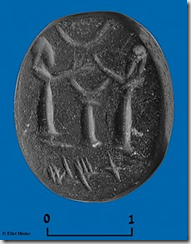The "First Temple Seal" is Probably Not
 See the post here by Jim West for the details. Initially, Eilat Mazar suggested the name on the seal was “Temech,” a name also mentioned among the returned exiles in Nehemiah, therefore linking the seal to the 1st Temple Period.
See the post here by Jim West for the details. Initially, Eilat Mazar suggested the name on the seal was “Temech,” a name also mentioned among the returned exiles in Nehemiah, therefore linking the seal to the 1st Temple Period.
That would be nice. However, some scholars think this is a misreading: the script is tough, but it is said that it’s clearly not t-m-ch, but probably sh-l-m-t. That is, Shulamit, or Shelamit, or Sh’lomot, or something (impossible to tell and we don’t know the range of possibilities for Hebrew names).
There is another option though. In my novice opinion (I don’t do Hebrew inscriptions of this era), Temech pretty clearly seems wrong. “טמח” only works if you read the lettering backwards, which for a Hebrew seal is right to left, not the other way around. Since it’s a seal to be impressed upon wax or some other substance, in order for the impression to look right, the letters must be carved from left to right, and in mirror-image of what they should look like. Take a look at the following Paleo-Hebrew chart:

In order from left to right, the first letter appears to be a het (h) or shin/sin (s) depending on whether that vertical line on the right is part of the first letter or is a second letter; if the latter, then it is unlike any of our options (which prb. makes a het more likely) and therefore could be one of several things: lamed (l), vav (w), peh (p), gimel (g), yodh (y), kaf (k), but not ecessarily a lamed; the next is clearly a mem (m); the last is clearly a tav (t); so either we have חמת (i.e. what Mazar’s suggestion should’ve been–Chamat or something) or ש–מת. Whatever it is, it’s not Temech.
The icon is also being interpreted to suggest the individual was a priest–namely because it looks like the two individuals are beside an altar. But the image is a bit vague: I’m not certain what that object is or why those people have their hands raised. Seems to me there could be other options.
Nevertheless, as West points out, this is another one of those over-zealous interpretations that got ahead of the data.
So as for date? I don’t know how you date seals, but I can tell you that Paleo-Hebrew was used consistently on coins up until the Herodian dynasty. So at least on that point it certainly need not be 1TP.
Paul Helm vs. Peter Enns, (Re)redux
 I recently learned that Paul Helm, prof of history, religion, and philosophy at King’s College (London) wrote a response to Pete Enns’ response to Pete’s book, Inspiration and Incarnation.
I recently learned that Paul Helm, prof of history, religion, and philosophy at King’s College (London) wrote a response to Pete Enns’ response to Pete’s book, Inspiration and Incarnation.
I have to admit, I’m a bit tired of the fuss over this little book. There are a couple of reasons. First, it’s not academic. It’s pop. And rather than engage it as pop, folks engage it as though it’s academic, with a full-on frontal assault. And rather than try to engage the issues that Enns does–which are real–, whether to disagree or offer viable alternatives, most whip out the gattling guns and try to rip it to shreds as though it’s solutions were life-threatening. Some good points are raised–I agree with some of the criticisms of Pete’s “incarnational analogy”–but an awful lot of wilful misreading, rhetoric, silly criticisms, and few real alternatives for dealing with the issues Pete tries to address. I’m not opposed to disagreement, including on Pete’s book about of which I have my own–its part academic progress–but not like this.
Helm’s 2nd piece isn’t all that different. It’s more respectful than his last one, for which I think he deserves credit. And he acknowledges that he’s not an OT scholar and tries to sidestep that fact by focusing instead on “(theological) method”: since it is logically prior to interpretation, he can do that without actually touching the issues. (which sounds like getting your cart before your horse to me)
I think a paragraph that encapsulates what I find problematic in Helm’s response is the following:
The Church holds fast to the divinely-breathed character of Scripture while recognising its all too obvious human properties. The books are breathed by God and authored by men. Such a confession throws up difficulties; hermeneutical difficulties, including those difficulties to which Professor Enns is at pains to draw our attention, those posed by the awareness of non-biblical data on our understanding of Scripture, and the New Testament’s use of the Old. But – if we are to be consistently and thoroughly Christian – these difficulties may perplex us but we should patiently await their resolution in a way that is consistent with the Christian view of Holy Scripture, the teaching of Christ and the Apostles, while all the while holding fast to that doctrine. Difficulties drawn from extra-biblical parallels should not lead us to stress the human character of Scripture at the expense of the divine – indeed we must especially be on our guard not to do this – any more than in our doctrine of providence moral and other difficulties ought to make us flinch from confessing that the Lord works all things after the counsel of his own will.
A few reflections:
(1) “But–if we are to be consistently and thoroughly Christian–…we should patiently await their resolution in a way that is consistent with the Christian view of Holy Scripture…” OK, this is patently circular. Helm has a priori decided on a particular doctrine of scripture–which in theory he should derive from scripture–before he reads the Bible; he wants to read through his doctrine the very things that should inform it. It’s not surprising, then, that the historical problems are at variance with Helm’s doctrine: he hasn’t integrated all the data, something Enns is trying to do (confessedly, as a Bible-believing Christian). Those difficulties are things that inform what doctrine of scripture you have; they’re not things to be resolved by imposing an already assumed doctrine on it. In my opinion, Helm’s view is therefore rather un-protestant.
(2) “…should not lead us to stress the human character of scripture at the expense of the divine…” This criticism–which others have raised too–presumes that the Bible has “divine” and “human” characteristics that are isolatable from each other, such that one could emphasize one aspect over another–as though “language” were human but “truth” were divine or something. This is wrong. Every aspect of the Bible that is human is simultaneously divine as well (which one area where the incarnation works as an analogy). Rather than say the Bible is “divine and human” it is probably more helpful to say it’s “divine-human.” Similarly, those difficulties that individuals like Helm find disturbing are just as much part of the human character of the Bible as they are part of the divine character. In other words, emphasizing one at the expense of the other is a logical impossibility that misunderstands the Bible’s divine-human makeup; to stress one, by definition, is to stress the other. Studying how they work in historical context (e.g. in terms of parallels, ancient interpretive practices) is, therefore, asking simultaneously a divine-and-human question: what was God doing when he used people, their thoughts, their conventions, their texts, to communicate a message in their words?
(3) Like others, Helm offers no alternative for dealing with the issues. He encourages patience; but “patience” means that scholars need to work to find viable answers to make sense of the data, which is what Pete is doing. Answers are not going to materialize on their own. And as of now, as far as I can tell, Enns has the only viable option–that is, apart from unbelief. (Though I’m not entirely satisfied with his option, but for very different reasons than Helm)
(4) I seriously wonder whether the “human properties” of the Bible are “all too obvious” to Helm. In my opinion, it seems to me that some of the issues are so glaring now in the 21st c.–e.g. synoptic problems, historical errors, the development of the canon and OT texts, the involvement of church/Jewish tradition–it would also be obvious that many solutions Protestant theologians have offered for centuries are simply not viable. I would think that if they were really “obvious,” Prof. Helm would welcome Enns’ attempts to deal with them Christianly and join the effort to find a workable Christian answer using his own expertise–or at very least, would be much more charitable and sympathetic to Enns’ concerns as an OT scholar in whose face the issues stare daily.

 RSS Feed
RSS Feed